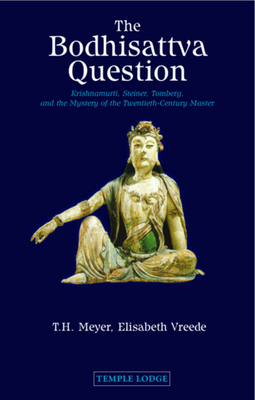The Bodhisattva Question: Krishnamurti, Steiner, Tomberg, and the Mystery of the Twentieth-Century Master

The Bodhisattva Question: Krishnamurti, Steiner, Tomberg, and the Mystery of the Twentieth-Century Master
According to Eastern tradition, the twelve sublime beings known as bodhisattvas are the great teachers of humanity. One after another, they descend into earthly incarnation until they fulfil their earthly missions. At that point, they rise to buddahood and are no longer obliged to return in a physical form. However, before bodhisattvas becomes a buddhas, they announce the name of their successors. According to Rudolf Steiner, the future Maitreya Buddha--or the "Bringer of Good," as his predecessor named him--incarnated in a human body in the twentieth century. Presuming this to be so, then who was this person? Theosophists believed they had discovered the bodhisattva in an Indian boy named Krishnamurti, who did indeed grow up to become a teacher of some magnitude. Adolf Arenson and Elisabeth Vreede, both students of Steiner, made independent examinations of this question in relation to Steiner's personal mission. They reached contrasting conclusions. More recently, a claim has been made that Valentin Tomberg--a student of Anthroposophy but later an influential Roman Catholic--was the bodhisattva. In this book, Meyer analyzes these conflicting theories and demonstrates how the question can be useful as an exercise in developing sound judgment in spiritual matters. Elisabeth Vreede's two lectures on the subject, included here in full, are a valuable contribution to our understanding of the true nature and being of Rudolf Steiner. Includes a new afterword by T. H. Meyer and Carla Vlad. C O N T E N T S Preface to New EditionIntroduction PART ONE 1. Concerning the Light of Free Insight2. A Childhood in India3. The Origin and Aim of the Theosophical Movement4. The Fundamental Christological Error of the Theosophists5. The Beginning of the End of the Theosophical Society6. The Two Sources of All Illusion7. An "Initiation" at a Youthful Age and Rudolf Steiner's Compensatory Deed8. The One Source of All Infallibility9. Division of the Spirits10. A Dream Comes to an End11. Rudolf Steiner and the Bodhisattva Question in the 20th Century12. Concluding Perspectives PART TWO Introduction to Elisabeth Vreede's LecturesThe Bodhisattva Question in the History of the Anthroposophical SocietyTwo Lectures Given by Elisabeth Vreede in Stuttgart, July 9 & 11, 1930 A Po
PRP: 116.92 Lei
Acesta este Prețul Recomandat de Producător. Prețul de vânzare al produsului este afișat mai jos.
93.54Lei
93.54Lei
116.92 LeiLivrare in 2-4 saptamani
Descrierea produsului
According to Eastern tradition, the twelve sublime beings known as bodhisattvas are the great teachers of humanity. One after another, they descend into earthly incarnation until they fulfil their earthly missions. At that point, they rise to buddahood and are no longer obliged to return in a physical form. However, before bodhisattvas becomes a buddhas, they announce the name of their successors. According to Rudolf Steiner, the future Maitreya Buddha--or the "Bringer of Good," as his predecessor named him--incarnated in a human body in the twentieth century. Presuming this to be so, then who was this person? Theosophists believed they had discovered the bodhisattva in an Indian boy named Krishnamurti, who did indeed grow up to become a teacher of some magnitude. Adolf Arenson and Elisabeth Vreede, both students of Steiner, made independent examinations of this question in relation to Steiner's personal mission. They reached contrasting conclusions. More recently, a claim has been made that Valentin Tomberg--a student of Anthroposophy but later an influential Roman Catholic--was the bodhisattva. In this book, Meyer analyzes these conflicting theories and demonstrates how the question can be useful as an exercise in developing sound judgment in spiritual matters. Elisabeth Vreede's two lectures on the subject, included here in full, are a valuable contribution to our understanding of the true nature and being of Rudolf Steiner. Includes a new afterword by T. H. Meyer and Carla Vlad. C O N T E N T S Preface to New EditionIntroduction PART ONE 1. Concerning the Light of Free Insight2. A Childhood in India3. The Origin and Aim of the Theosophical Movement4. The Fundamental Christological Error of the Theosophists5. The Beginning of the End of the Theosophical Society6. The Two Sources of All Illusion7. An "Initiation" at a Youthful Age and Rudolf Steiner's Compensatory Deed8. The One Source of All Infallibility9. Division of the Spirits10. A Dream Comes to an End11. Rudolf Steiner and the Bodhisattva Question in the 20th Century12. Concluding Perspectives PART TWO Introduction to Elisabeth Vreede's LecturesThe Bodhisattva Question in the History of the Anthroposophical SocietyTwo Lectures Given by Elisabeth Vreede in Stuttgart, July 9 & 11, 1930 A Po
Detaliile produsului










